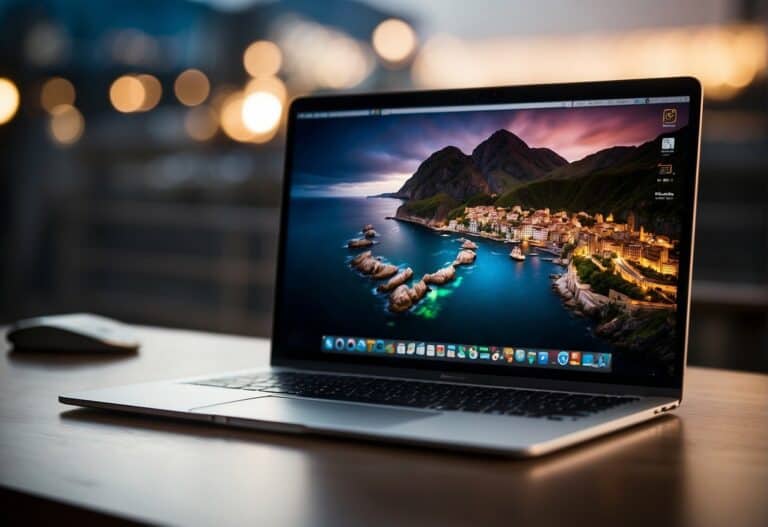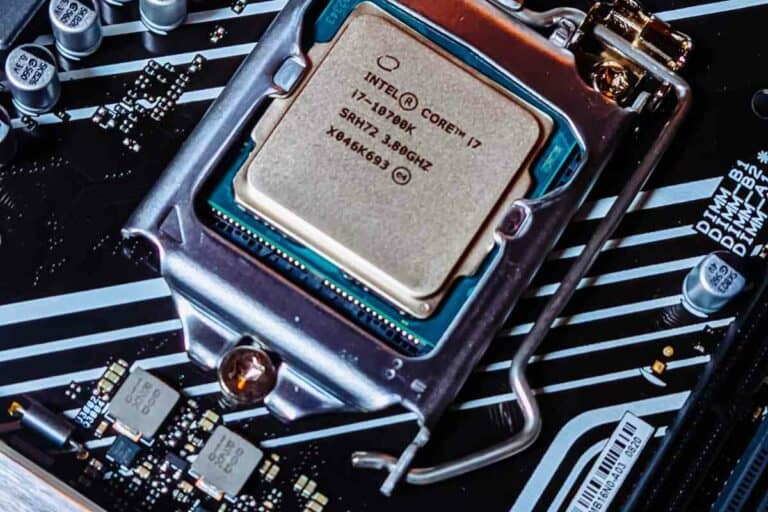Setting Up Your New MacBook Air: A Quick Start Guide
Welcome to your new MacBook Air! Let’s get you set up and exploring its full potential in no time.

Unboxing Your MacBook Air
As we take the first exciting steps with our new MacBook Air, it’s vital to ensure everything is in place and in perfect condition before we dive into using this sleek machine.
Checking the Package Contents
Upon opening the box, we should see a neatly packed MacBook Air, which is the star of the show, along with a few essential accessories that Apple includes to get us started. Here’s what we’re typically looking for:
- MacBook Air: The main event, make sure it’s the correct model and specifications we ordered.
- Power adapter: This is a USB-C power adapter for charging our MacBook.
- USB-C Charge Cable: A 2-meter cable that connects to our power adapter.
- Documentation: This includes the setup guide and warranty information.
I still remember the joy of unboxing my first MacBook Air; peeling off the protective film felt like unwrapping the future.
Inspecting for Damage
Before we get too carried away with setting up our new gadget, it’s critical to give it a visual once-over.
Things to look out for:
- Screen: No cracks or dead pixels
- Body: No dents or scratches
- Keyboard and Trackpad: Should be intact and unblemished
During the unboxing of a previous MacBook, I noticed a small scratch on the underside—a quick call to Apple and they sorted it out with a replacement. It’s always worth that second glance. If anything seems amiss, it’s best to contact Apple support immediately to resolve any issues.
Initial Setup Process

When we take our new MacBook Air out of the box, the first steps to get it up and running are crucial. We’ll guide you through the essential stages to begin using your MacBook Air — from turning it on to connecting to Wi-Fi, and setting up your macOS user account.
Turning on Your MacBook Air
Upon lifting the lid of your MacBook Air, it automatically powers on. This is our first experience with the simplicity of Apple’s design — no power button searching needed. If it doesn’t turn on automatically, the power button is located in the top right corner of the keyboard, doubling as the Touch ID sensor.
Setting Up macOS
Next up, the macOS Setup Assistant will greet us. This built-in friend helps configure our settings. I remember the first time I set up my MacBook Air; entering my Apple ID felt like being welcomed into an exclusive club. The Setup Assistant will prompt us to choose a language, a keyboard layout, and even enable services like Siri and Find My.
Connecting to Wi-Fi
Before diving into the world of macOS, our MacBook Air needs an internet connection. The Setup Assistant makes it easy for us to find and connect to a Wi-Fi network. Simply select the Wi-Fi icon at the top of the screen, choose our network, and enter the password.
Creating Your User Account
Creating a user account is our final step before we can explore macOS. Here, we’ll choose a username and password, set up our iCloud account, and decide on our level of privacy. Remember that the username we pick will also be our home folder name, so choose wisely!
To aid in understanding, here’s a quick reference table summarizing the key steps:
| Step | Action |
|---|---|
| Power On | Open lid or press power button |
| Initial Setup | Follow macOS Setup Assistant |
| Wi-Fi Connection | Choose network and enter password |
| Account Creation | Decide on username and privacy settings |
Embarking on the adventure with a new MacBook Air is always exciting. These initial setup processes are just the beginning of what will surely be a seamless and enjoyable user experience.
Personalization

When we unwrap a new MacBook Air, the real joy begins with personalizing our space. It’s about making the device truly ours, from the system preferences to the dock and trackpad.
Adjusting System Preferences
The first step in personalization is to navigate to the System Preferences. This is where we set the stage for our user experience. Let’s begin with the basics:
| Appearance | Description |
|---|---|
| Light | Offers a bright and airy interface. |
| Dark | Ideal for low-light environments. |
| Auto | Alternates between light and dark based on time. |
Through the System Settings, we can adjust and customize settings like wallpaper, accent colors, and more to match our personal style.
Customizing the Dock
Our dock is like our home base; it should have everything we need at a glance.
- Size: Drag the slider to adjust the dock size to your preference.
- Magnification: Enable magnification so icons enlarge when hovered over.
- Position: Move the dock to either side of the screen or keep it at the bottom.
By right-clicking the Dock, we access options to further refine its behavior and look, streamlining our workflow.
Setting Up Trackpad Gestures
The trackpad on the MacBook Air is a powerhouse for gestures, and here’s where we can tailor it to our needs:
- Go to Trackpad settings in the System Preferences.
- Choose between Point & Click, Scroll & Zoom, and More Gestures tabs.
We personally love the “three-finger drag” for moving windows around with ease—it feels like we’re conducting our own symphony of apps.
By utilizing these personalization tips, we can turn our MacBook Air into a device that fits snugly into the flow of our daily lives, enhancing productivity and enjoyment.
Data Transfer Options
When we get a new MacBook Air, one of the first tasks we need to tackle is transferring our data. We have two primary methods: using the built-in Migration Assistant or transferring files manually. Each method suits different needs, and we’ll explore how to use them effectively.
Using Migration Assistant
Migration Assistant is Apple’s tool for moving your information—like user accounts, documents, and applications—from one Mac to another. It’s straightforward and saves us a lot of time. Here’s how it works in brief:
- Ensure both Macs are on the same Wi-Fi network or connected via Ethernet.
- Update the software on both Macs for compatibility.
- Open Migration Assistant on the new MacBook Air, which can be found in the Utilities folder.
Using Migration Assistant, it’s also possible to transfer content from other sources, such as a Time Machine backup, a Windows PC, or an iPhone. Remember, if any issues arise during the migration process, it’s quite common and can often be resolved with a simple restart of either device or double-checking network settings.
Transferring Files Manually
Sometimes we prefer a hands-on approach, or perhaps we only need to move a few specific files. Transferring files manually might seem more laborious, but it does give us full control. Here’s what we should keep in mind:
- Connect an external hard drive or use a cloud service to transfer the files.
- Manually copy important folders such as Documents, Downloads, Music, and Pictures.
- Don’t forget to also export and import bookmarks from browsers and transfer email settings if necessary.
But here’s a little nugget from personal experience: I’ve found dragging and dropping folders onto an external drive and then onto the new Mac to be foolproof, albeit a tad time-consuming.
| Method | Pros | Cons |
|---|---|---|
| Migration Assistant | Quick, transfers most data, easy to use | Potential compatibility issues |
| Manual Transfer | Full control over what gets transferred | Time-consuming for large amounts of data |
While Migration Assistant is seamless and efficient for comprehensive migrations, manually transferring files is unmatched for selective moves. Our choice depends on what’s more convenient and necessary for our situation.
Software Installation
Once you unpack your MacBook Air and power it on, the first major task is installing software. High-quality apps enhance the functionality of our Mac, streamline our workflow, and make sure we’re prepared for any task at hand.
Installing Essential Apps
To ensure our MacBook Air meets all our computing needs, we meticulously select and install essential applications. This includes productivity tools, media players, and security software. We begin by navigating to the App Store where a myriad of apps await our perusal.
- Productivity: Pages, Numbers, and Keynote are must-haves for document creation and presentations.
- Media: VLC or IINA for diverse video format support.
- Security: Malwarebytes or Norton to safeguard our device.
In my own experience, I find that a combination of Alfred for workflow optimization and Bear for note-taking significantly elevates my productivity.
Setting Up Email and Calendar
Setting up our email and calendar is crucial for keeping our communication and scheduling in sync. We go to the Mail app and enter our email details, and upon doing so, our calendar entries often auto-populate in the Calendar app. Here’s a quick rundown:
Mail:
- Open Mail.
- Choose Mail > Add Account.
- Select the provider and follow the prompts.
Calendar:
- Open Calendar.
- Choose Calendar > Preferences.
- Add accounts in the Accounts tab.
I remember integrating my email and calendar last year; it was straightforward and transformed my daily planning.
Organizing the Applications Folder
Keeping the Applications folder organized is something we find invaluable. It makes locating software a breeze and maintains a clutter-free environment. We achieve this by:
- Categorization: Grouping similar apps into subfolders (e.g., “Productivity” and “Multimedia”).
- Cleanup: Regularly uninstalling apps we no longer use.
It’s deeply satisfying opening my Applications folder to see everything neatly categorized — a small action that saves us time in the long run.
Security Settings
When we get our hands on a new MacBook Air, ensuring our data stays secure is a top priority. Here are some of the essential security settings we need to configure right away:
Enabling FileVault
FileVault is an encryption system that protects the data on our Mac’s hard drive. To Enable FileVault, we go to System Preferences, select Security & Privacy, and then the FileVault tab. We click on the lock icon, enter our administrator password, and select “Turn on FileVault.” We’ll then choose how we want to unlock our disk and reset our password if needed.
For more information on how to set up FileVault, visit Apple’s guide on Mac security.
Setting Up Touch ID
Touch ID not only makes unlocking our MacBook Air convenient but also adds an extra layer of security. To set it up, we open the System Preferences and click on Touch ID. Here we can add our fingerprint and manage our Touch ID settings, including using it for Apple Pay or to unlock apps.
To get more details on using Touch ID, you can read about security features for MacBook Air.
Creating a Firmware Password
Creating a firmware password prevents others from starting up our Mac from any disk other than the designated startup disk. We do this by restarting our Mac and, immediately upon hearing the startup chime, pressing and holding Command (⌘) + R to enter the macOS Recovery mode. Once there, we can click on Utilities in the menu bar, then select Firmware Password Utility, and follow the onscreen instructions.
Refer to Change Privacy & Security settings on Mac for a graphical walkthrough.
In my experience, setting a firmware password gave me peace of mind during travel. It ensures that no one else can boot my MacBook Air if it gets into the wrong hands.
Backup Solutions
When we set up our new MacBook Air, ensuring our data is safe and secure is vital. Let’s explore how to use Time Machine and what to consider when selecting an external hard drive for backups.
Using Time Machine
Time Machine is an integrated backup feature on macOS that automatically saves copies of our files, apps, and system files. To begin, we’ll need an external storage device; once it’s plugged in, a prompt will appear asking if we wish to use this drive for Time Machine. After confirming, Time Machine will take care of the rest, performing hourly backups for the past 24 hours, daily backups for the past month, and weekly backups for all previous months. Our first backup might take a while, but after that, only incremental changes are stored, which speeds up the process substantially.
Choosing an External Hard Drive
When it comes to external hard drives, the two main aspects we need to consider are storage capacity and connection type. Ideally, our backup drive should have at least twice the storage of our MacBook’s internal drive. Regarding connection types, USB-C or Thunderbolt drives are the most efficient for MacBooks due to their fast data transfer rates. Here’s a quick comparison table to help us decide:
| Storage Capacity | Connection Type | Speed | Notes |
|---|---|---|---|
| 1TB | USB 3.0 | Up to 5 Gbps | Cost-effective, compatible with USB-C with an adapter |
| 2TB | USB-C | Up to 10 Gbps | More expensive, future-proofed for new MacBook models |
| 2TB | Thunderbolt 3 | Up to 40 Gbps | Premium price, fastest option for data-intensive tasks |
In my personal use, I’ve found that a 2TB drive with a Thunderbolt 3 connection allows us to rest easy, knowing our large video projects and photo libraries are backed up quickly and efficiently.
By selecting the right tools and following these steps, we ensure that our precious memories and important documents are secure.
Peripherals and Accessories
When we get our hands on a new MacBook Air, it’s exciting to explore the possibilities it holds, not just within its sleek framework but also through the variety of peripherals and accessories we can connect to enhance our experience.
Pairing Bluetooth Devices
Pairing Bluetooth devices with our MacBook Air is a breeze. We can connect a wireless mouse, keyboard, or speakers to our Mac by simply turning on these devices, going to System Preferences > Bluetooth, and clicking “Connect” next to the device we want to pair. Remember to keep the device close to the MacBook during pairing to ensure a smooth setup process.
Using USB-C Ports for Accessories
The MacBook Air’s USB-C ports are versatile, allowing us to plug in a multitude of accessories. While Apple has fully embraced USB-C, not all our peripherals have, which sometimes calls for adapters. A common setup includes:
- USB-C to USB adapter for legacy devices
- USB-C hub for multiple connections
- USB-C to HDMI for external displays
We’ve found that a good quality USB-C hub is almost essential. It can turn the single port into several, giving us options for HDMI, SD cards, and more traditional USB ports. In our experience, opting for a hub with additional power delivery means we can charge our MacBook Air at the same time we’re using other peripherals.
Troubleshooting Common Issues
When we get our hands on a new MacBook Air, we’re eager to dive into its sleek design and powerful features. But sometimes, we might encounter a hiccup or two. Here’s a quick guide we’ve come up with to smooth out those early bumps in the road.
If the MacBook Air fails to start up, it could be a simple issue with the display or power supply. Our first step is to check if the machine is off or just the screen. Does the Caps Lock key light up? If yes, it’s likely a screen issue. A simple reset may do the trick.
Experiencing slow performance or software glitches? It could be related to outdated software. We always make sure our macOS is up to date. Apple regularly provides updates that can solve these sorts of problems.
For more persistent issues, we may need to delve a bit further:
| Common Problem | Steps to Troubleshoot |
|---|---|
| MacBook won’t turn on | Check power source; reset SMC |
| Unresponsive application | Force quit (Option, Command, Esc); restart MacBook |
| Slow performance | Verify available storage; consider resetting NVRAM |
Remember the time our MacBook didn’t respond? We simply force quit the frozen app and it was smooth sailing afterward.
Lastly, hardware concerns such as unresponsive keyboards or trackpads may require a visit to an Apple Store or an authorized service provider – but these are thankfully rare. Keep these tips in mind and we’ll be well-equipped to tackle common issues with our new MacBook Air.
Performance Optimization
When setting up your new MacBook Air, optimizing its performance from the get-go can make all the difference in how it runs both now and down the line. We’ll focus on conducting software updates and managing storage space to keep your machine running smoothly.
Conducting Software Updates
To ensure your MacBook Air runs efficiently and securely, it’s crucial to keep its software up to date.
- Step One: Click on the Apple menu and select “System Preferences.”
- Step Two: Click on “Software Update.”
- Step Three: If updates are available, click “Update Now.”
Regularly updating your macOS can resolve hidden bugs and enhance overall stability. From my experience, a freshly updated system often feels snappier and more responsive, and sometimes it even addresses those tiny annoyances we didn’t notice were dragging us down (It’s amazing how a simple update eliminated the little lag I experienced with my touchpad!).
Managing Storage Space
Keeping tabs on your MacBook’s storage helps maintain its performance. A cluttered drive can slow things down significantly, so it’s best to start managing space early on.
- Step One: Click the Apple menu, select “About This Mac,” and then “Storage.”
- Step Two: Click “Manage…” to see recommendations for optimizing storage.
By routinely reviewing my storage and clearing space, I’ve noticed my MacBook Air maintains its zip and vigor, especially during resource-heavy tasks like video editing or when I have dozens of tabs open while researching.
| Action | Effect on MacBook Air Performance |
|---|---|
| Delete large files | Frees up space, enabling smoother operation |
| Uninstall unused apps | Reduces clutter, can improve loading times |
| Empty Trash regularly | Clears old data, potentially speeds up file navigation |
It’s in our best interest to take these steps seriously to ensure our MacBook Air stays as agile as it was the day we unboxed it.
Tips and Tricks
When we first unbox our new MacBook Air, we’re met with the simplicity and elegance that we’ve come to expect from Apple products. But beyond the sleek design, there’s a treasure trove of features waiting to enhance our user experience.
Customize the Dock
The Dock is an integral part of the macOS experience, and tailoring it to our needs can make a world of difference. To keep our workspace clean and efficient, we manage our Dock by adding applications we use frequently and removing the ones we don’t need. An organized Dock means a smoother workflow and quicker access to our tools.
- To add an app to the Dock, open Finder, locate the app, and simply drag it to the Dock.
- To remove an app, right-click on the icon in the Dock and choose “Options,” then “Remove from Dock.”
Keyboard Shortcuts
Our productivity can skyrocket with a solid grasp of keyboard shortcuts. Remembering CMD+C for copy and CMD+V for paste is just the beginning. Here’s a quick reference table:
| Action | Shortcut |
|---|---|
| Show Spotlight Search | CMD + Spacebar |
| Take Screenshot | Shift + CMD + 4 |
| Lock Screen | CMD + Control + Q |
Trackpad Gestures
Apple’s trackpad gestures are like hidden spells, making navigation and multitasking magical (and we’re not even exaggerating). Exploring these gestures has significantly sped up our browsing and working processes.
- Swipe up with three fingers to access Mission Control.
- Use two fingers to scroll up or down on pages.
Data Migration
Transferring data to our new MacBook can initially seem daunting, but Apple’s Migration Assistant simplifies it. We’ve found that this tool seamlessly imports data from an old Mac or even a Windows PC without a hitch.
For a deeper dive into setting up your MacBook Air, you’ll find 7 essential tips for your new MacBook Air incredibly useful. And, if you’re looking for more advanced features to try out, 11 tips for setting up your new Mac offers a great next step.
More Macbook Air Articles: (Read These Next)
- Best MacBook Air Models
- MacBook Air Buying Guide
- Setting Up Your New MacBook Air
- MacBook Air Storage Options
- MacBook Air for Students
- MacBook Air vs MacBook Pro
- Enhancing MacBook Air Performance
- Top MacBook Air Accessories
- Solving Common MacBook Air Problems
- MacBook Air for Writers
- Latest macOS Features for MacBook Air
- MacBook Air for Remote Work
- Buying a Refurbished MacBook Air
- MacBook Air Keyboard Shortcuts
- MacBook Air for Travel
- Securing Your MacBook Air
- MacBook Air and the Apple Ecosystem
- MacBook Air Screen Features
- Personalizing Your MacBook Air
- MacBook Air for Content Creation
- Transitioning to MacBook Air from PC
- MacBook Air for College
- Light Gaming on MacBook Air
- Extending MacBook Air Battery Life
- MacBook Air Connectivity and Ports
- Using MacBook Air in Small Businesses
- Reviewing the MacBook Air with M1 Chip
- MacBook Air vs Windows Ultrabooks
- Sustainable Use of MacBook Air
- Anticipating Future MacBook Air Developments






